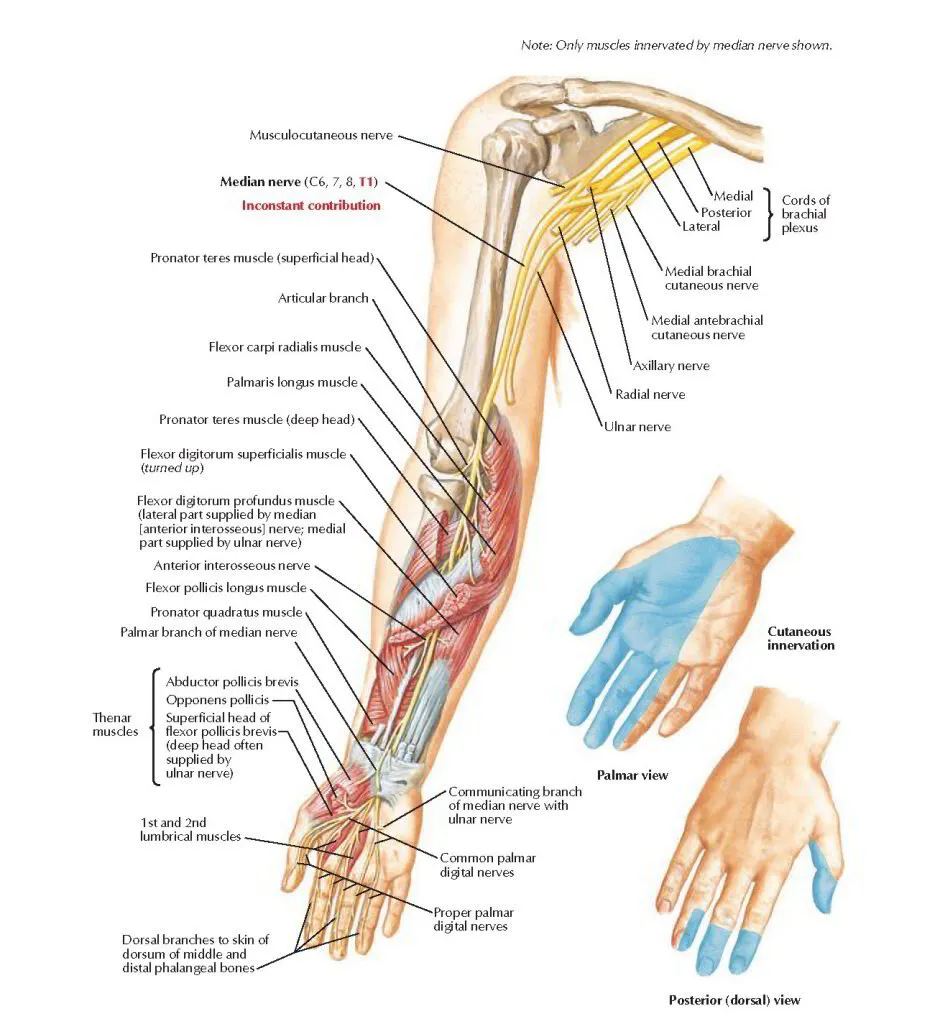Carpal Tunnel Syndrome (CTS) is the second most common muscoskeletal pregnancy symptom, after low back pain. It is a condition that occurs when the median nerve, which originates in the neck from the brachial plexus (nerves C5-T1 in the neck), and goes through biceps muscle into the forearm and travels into the palm of the hand, becomes pressed or squeezed at the wrist. This can result in a burning sensation, parasthesia (numbness/tingling) in the fingers or hand, and may even affect arm and grip strength.
Why Does Carpal Tunnel Syndrome Occur During Pregnancy?
The physical changes that accompany pregnancy, such as fluid retention and weight gain, can lead to increased pressure on the median nerve. The body's blood volume doubles during pregnancy and hormonal changes produce increase fluid production, which causes swelling. Other hormonal fluctuations, produced from a pregnancy hormone, relaxin, may also contribute to inflammation, which can cause relaxation of the transverse carpal ligament, exacerbating the symptoms. Recognizing these factors is crucial for finding effective and holistic solutions.
Diagnosis of Carpal Tunnel Syndrome:
To diagnosis CTS, your doctor will start with a history of your symptoms, and then do a physical exam. The median nerve supplies sensory and motor function to your forearm, wrist, and hand so they will likely check the sensation in your palm and hand (see pic above to see the median nerve distribution). They will also likely do at lease one of the following orthopedic tests: Phalen's Test, Tinel's Test, or the Carpal Compression Test. Other diagnostic testing they may order include: an ultrasound, electromyography, and nerve conduction study. Some doctors will order an x-ray, for non-pregnant patients, to rule out other causes of your symptoms (like arthritis or a fracture).
Holistic Tips for Managing Carpal Tunnel Syndrome During Pregnancy
1. Chiropractic Care for Pregnancy:
Chiropractic adjustments can play a significant role in relieving pressure on the median nerve. They will do a thorough history, consultation, and examination of your spine, nervous system, and median nerve to determine what is causing your symptoms. Chiropractors use gentle techniques that are safe during pregnancy to align the spine and alleviate pressure on nerves. Many of our pregnant clients over the years have reported significant relief from their CTS symptoms with chiropractic care!
2. Wrist Exercises and Stretches:
Simple exercises and stretches can help maintain flexibility and reduce tension in the wrists. Consult with a healthcare professional or a prenatal exercise specialist for specific recommendations, but we like some of these stretches and exercises.
3. Maintain Proper Posture:
Correct posture is crucial in preventing additional stress on the wrists. Pay attention to ergonomics, especially when sitting or working for extended periods.
4. Cold and Warm Compress:
Applying cold compresses can help reduce swelling & inflammation, while warm compresses can alleviate muscle tension. Use them alternatively for relief.
5. Acupuncture:
Some pregnant individuals find relief through acupuncture. This ancient practice involves inserting thin needles into specific points to promote energy flow and reduce pain.
7. Nutritional Support:
We know that inflammation in our body can put more pressure on nerves and cause more pain. Maintain a balanced diet rich in anti-inflammatory foods, such as omega-3 fatty acids found in fish, flaxseeds, and walnuts. Consult a healthcare provider for personalized advice.
8. Wearing a Splint:
Wearing a wrist splint at night can help keep the wrist in a neutral position, reducing pressure on the median nerve and alleviating symptoms during sleep.
Experiencing Carpal Tunnel Syndrome during pregnancy or postpartum can be challenging, but holistic approaches, including chiropractic care, can provide relief. Embrace a combination of lifestyle modifications, exercises, and natural therapies to manage symptoms effectively. Pregnancy is a unique journey for each person, and with the right care, it can be a more comfortable and enjoyable experience!
Always consult with your healthcare provider before starting any new treatment regimen. (Please note that sudden swelling of your hands during pregnancy, or continued swelling after birth can be a sign of preeclympsia and is reason to contact your doctor immediately.)
